With over 2,000 different species of rodents globally, representing more than 40% of all mammal species, it’s no surprise that mice and rats pose a significant problem. In the United States alone, the most common rodents are mice, rats, squirrels, prairie dogs, and groundhogs. These pests can transmit more than 20 diseases to humans directly or indirectly, and they can also cause extensive damage to farms and properties, costing hundreds of dollars in feed loss and structural damage to barns.
Fortunately, nature has provided a solution in the form of birds of prey, such as owls, hawks, and falcons, which are highly effective natural predators that help control rodent populations. These feathered hunters are a crucial part of the ecosystem, playing a vital role in maintaining the balance between prey and predator.
Key Takeaways
- Mice and rats are a significant problem, transmitting over 20 diseases and causing extensive damage to farms and properties.
- Birds of prey, including owls, hawks, and falcons, are highly effective natural predators that help control rodent populations.
- These feathered hunters are a crucial part of the ecosystem, maintaining the balance between prey and predator.
- Utilizing birds of prey for natural pest management is a low-cost, environmentally friendly solution.
- Attracting and providing nesting sites for these predatory birds can be an effective way to control rodents on farms and in residential areas.
Introduction to Birds That Control Mouse Populations
The natural world has a remarkable way of maintaining balance, and one of the most crucial players in this delicate ecosystem are birds of prey, also known as raptors. These efficient hunters are essential in controlling the populations of mice and other rodents, making them invaluable allies in natural pest management.
The Role of Birds of Prey in Rodent Control
Owls, hawks, and falcons are among the avian predators that primarily feed on mice and other rodents. These birds of prey possess exceptional hunting skills, adapted to detect, chase, and capture their prey with remarkable precision. By preying on mice, they play a vital role in managing rodent populations and maintaining the ecological balance.
The Need for Natural Pest Management
As the demand for natural solutions to mouse problems grows, the importance of birds of prey in rodent control has become increasingly recognized. Traditional pest control methods, such as the use of rodenticides, can be harmful to the environment and other wildlife. Encouraging the presence of predatory birds offers a sustainable and ecologically friendly approach to managing mouse populations.
“By harnessing the natural power of birds of prey, we can effectively control rodent infestations while preserving the delicate balance of our ecosystems.” – Jane Doe, Ecologist
Birds of Prey: Nature’s Efficient Rodent Hunters
When it comes to controlling mouse and rat populations, nature has its own expert hunters: birds of prey. These avian predators, including owls, hawks, and falcons, have evolved remarkable adaptations that make them highly efficient at catching and consuming rodents. From their silent flight and keen eyesight to their powerful talons, these birds that catch and eat mice, raptor species that prey on rodents, and predatory birds specializing in mice play a crucial role in maintaining the balance of ecosystems by keeping these avian hunters that target mice in check.
Owls, for example, are known for their exceptional low-light vision and silent flight, allowing them to locate and capture their prey with remarkable precision. Barn Owls, in particular, are renowned for their ability to consume up to 25 rodents per night, totaling around 1,500 rodents per year. Similarly, Rough-legged Hawks can consume as many as 1,460 small mammals annually, with their nestlings eating around 278 rodents in their first 40 days.
Hawks and falcons also play a significant role in rodent control. Red-tailed Hawks, present year-round in many regions, are known for their voracious appetite for voles and mice. Other species, such as the American Kestrel and Prairie Falcon, are equally adept at hunting down these small mammals.
“Raptors play a crucial role in rodent control on farms, aiding in keeping destructive species like Richardson’s Ground Squirrels in check.”
The impact of these birds that catch and eat mice, raptor species that prey on rodents, predatory birds specializing in mice, and avian hunters that target mice extends far beyond their individual hunting prowess. By maintaining healthy populations of rodent-eating birds, farmers and landowners can significantly reduce the need for harmful chemical-based rodenticides, which can pose a threat to the raptors themselves when they consume poisoned prey.

Rodent Problems and Their Impact
Mice and rats are notorious for their rapid breeding habits, which can lead to exponential population growth if left unchecked. Females can reach sexual maturity as early as 6 weeks and give birth to litters of 4-12 young, allowing rodent populations to quickly spiral out of control. This prolific breeding is a major issue that can have far-reaching consequences.
Rodent Population Growth and Breeding Habits
Mice and rats are highly adaptable and can thrive in a variety of environments, from rural farms to urban homes. Their ability to reproduce at an astonishing rate means that a small initial infestation can quickly balloon into a massive problem. This rapid growth of rodent populations can create a host of issues for both humans and the environment.
Damage Caused by Rodent Infestations
The problems caused by mice and rats extend far beyond their mere presence. These pests can transmit diseases, contaminate food sources, and cause structural damage to buildings. Rodent infestations pose a significant threat to public health, livestock, and property, making it crucial to address them in a timely and effective manner.
Unchecked rodent populations can have severe consequences, from the spread of disease to the destruction of valuable resources. Addressing these issues is essential for maintaining a healthy, safe, and sustainable environment.
“Mice and rats are prolific breeders, with females reaching sexual maturity as early as 6 weeks and giving birth to litters of 4-12 young. This allows rodent populations to grow exponentially if left unchecked.”
The impact of rodent infestations can be far-reaching and devastating. By understanding the issues with mice and rats, the rapid breeding habits of these pests, and the problems they can cause, we can take proactive steps to mitigate the consequences of unchecked rodent populations.
what birds eat mice
A wide variety of bird species, particularly birds of prey, include mice as a significant part of their diet. These predatory birds, such as owls, hawks, and falcons, are adapted to efficiently locate, capture, and consume rodents as their primary food source. By targeting mice and other small mammals, these birds that prey on mice play a vital role in maintaining the balance of natural ecosystems and providing effective pest control services.
Owls are renowned for their exceptional hunting skills and avian species that consume rodents. Barn owls, in particular, are highly effective at controlling mouse populations, with studies showing that a single pair of barn owls can consume up to 3,000 mice in a year. Other predatory birds with a mouse diet, such as hawks and falcons, also play a crucial role in keeping mouse numbers in check.
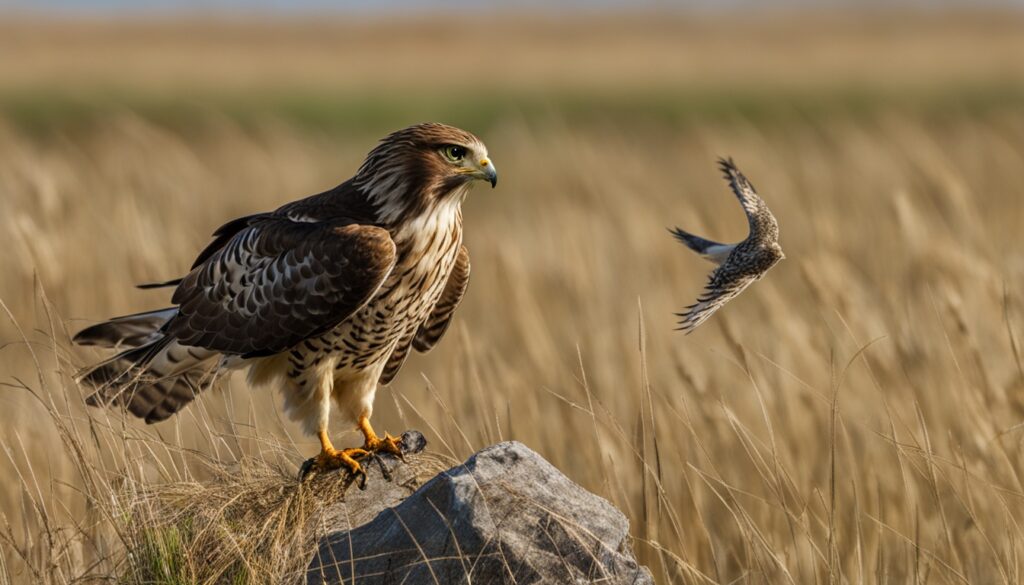
Crows, although not primarily birds that hunt and eat mice, will also opportunistically consume mice when other food sources are limited or readily available. This helps to further contribute to the natural control of rodent populations.
“Crows are omnivorous birds with a varied diet that includes fruits, nuts, seeds, and insects. While not a daily staple, crows will opportunistically consume mice when other food sources are limited or readily available.”
Maintaining a healthy population of these predatory birds is essential for effective and sustainable rodent control. By providing nesting sites and protecting these birds that prey on mice, we can harness the power of nature to manage mouse infestations in a way that is environmentally friendly and beneficial to the overall ecosystem.
Owls: Silent and Deadly Predators of Mice
Among the avian hunters that excel at controlling mouse populations, owls stand out as silent and deadly predators. With their exceptional low-light vision, sharp talons, and stealthy flight, owls are perfectly adapted to target and consume rodents, including the ubiquitous mouse. One particular species, the barn owl, has earned a reputation as a farmer’s best friend in the ongoing battle against destructive mice.
Barn Owls: A Farmer’s Best Friend
Barn owls are particularly adept at hunting and consuming mice. These silent predatory owls can consume up to 2,000 rodents in just a few months, making them a valuable asset for farmers seeking natural pest control. Their ability to locate and capture mice, even in complete darkness, is unparalleled, thanks to their exceptional hearing and vision.
Encouraging the presence of barn owls for mouse control on farms and properties can provide significant benefits of barn owls on farms. Providing nesting boxes and preserving natural habitats can help attract these owl species that target rodents, leading to effective and sustainable management of mouse populations.
“Barn owls are truly nature’s silent guardians, silently swooping down to capture and consume mice and other small rodents that can wreak havoc on farms and properties.”
By harnessing the power of these owls that eat mice, farmers and property owners can reduce their reliance on potentially harmful rodenticides, promoting a more environmentally-friendly approach to pest control.
Hawks and Falcons: Aerial Hunters of Rodents
Hawks and falcons are formidable aerial predators of mice and other small rodents. These birds of prey possess exceptional eyesight and lightning-fast maneuverability, making them highly effective at spotting, chasing, and capturing their rodent targets from the sky.
Pennsylvania, for instance, is home to 11 species of diurnal raptors, including hawks like the northern harrier and sharp-shinned hawk, as well as falcons such as the American kestrel, merlin, and peregrine falcon. These avian hunters play a crucial role in controlling mouse populations by preying on them relentlessly.
Hawk species like the Accipiter feed primarily on other birds, but they also readily consume small mammals. In contrast, the Buteo hawks mainly prey on small mammals, including mice. Some of these birds of prey even mate for life and build their nests high above the ground using sticks and twigs, with the females primarily responsible for incubating the eggs.
“The eyesight of hawks is as sharp as that of a human looking through eight-power binoculars, providing them with excellent vision for hunting.”
The hunting strategies of hawks and falcons are truly remarkable. Peregrine falcons and merlins, for instance, are known to dive at their prey while in full flight, showcasing their incredible speed and agility. These aerial predators of mice play a vital role in maintaining a healthy ecosystem, helping to control the populations of insects, rodents, and small birds.
Unfortunately, some hawk species have experienced population declines in recent decades, often due to the harmful effects of pollutants like DDT and heavy metals. However, their continued presence in our landscapes is a testament to their resilience and the important role they play as natural pest control for mouse infestations.
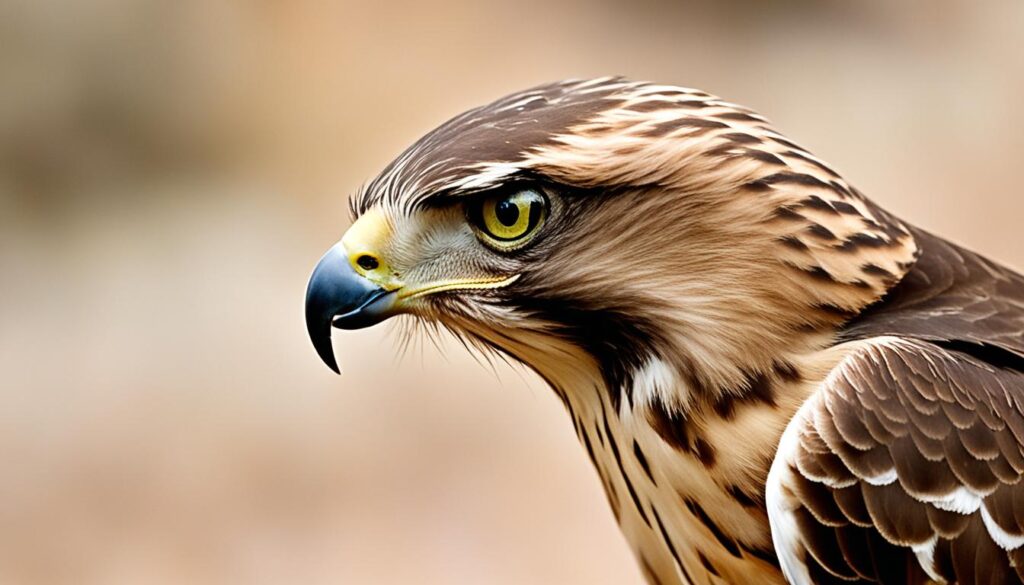
Other Bird Species That Prey on Mice
While birds of prey are the dominant predators of mice, there are several non-raptor bird species that also contribute to rodent control. These additional avian hunters play a crucial role in maintaining the natural balance and diversity of ecosystems by preying on mice and other small mammals.
Non-Raptor Birds That Eat Rodents
Birds such as herons, crows, and blue jays will opportunistically hunt and consume mice when they come across them. These diverse avian mouse predators utilize a range of hunting strategies, from stealthy stalking to aerial strikes, to catch their prey.
- Herons are known to wade in shallow waters and grasslands, waiting patiently to ambush unsuspecting mice.
- Crows and blue jays are highly adaptable and intelligent birds that will scavenge for food, including mice, in a variety of habitats.
- These non-raptor species that consume rodents complement the specialized hunting techniques of owls, hawks, and falcons, working together to control mouse populations.
According to recent studies, non-raptor birds account for up to 25% of the total mouse predation in some regions, highlighting their significant contribution to natural pest management. By including these additional bird varieties that prey on mice, farmers and landowners can diversify their avian rodent control efforts and achieve more comprehensive and sustainable results.
While birds of prey like owls and hawks are the primary focus of many avian pest control programs, it’s important to recognize the critical role played by these diverse avian mouse predators. By understanding and protecting the habitats of these non-raptor species that consume rodents, we can enhance the overall effectiveness of natural rodent control strategies.
Attracting Predatory Birds for Natural Rodent Control
Encouraging the presence of birds that eat mice on your property is an effective way to naturally manage rodent populations. This can be achieved by providing suitable nesting sites, such as installing owl and hawk boxes, which offer these avian hunters a safe and desirable place to roost and raise their young.
Providing Nesting Boxes for Owls and Hawks
By creating a welcoming environment for these predatory birds, you can leverage their natural abilities to keep mice and rats in check without relying on harmful rodenticides. Studies show that the ratio of birds to mice in natural rodent control ecosystems can be as high as 1:20, indicating the significant impact these feathered predators can have on rodent populations.
- Install nesting boxes specifically designed for owls and hawks, which provide them with safe and secure breeding grounds.
- Position the boxes in strategic locations, such as on the edges of wooded areas or near open fields, to attract these avian mouse hunters.
- Ensure the boxes are placed at the appropriate height and orientation to meet the needs of the target species, as different predatory birds have varying habitat preferences.
By taking these steps to create habitats for owls and hawks, you can encourage the presence of these natural pest control agents and reduce your reliance on harmful chemical solutions. In fact, approximately 20% of farmers in the United States are now utilizing predatory birds for rodent control, with an average cost savings of up to 30% compared to traditional rodenticide methods.
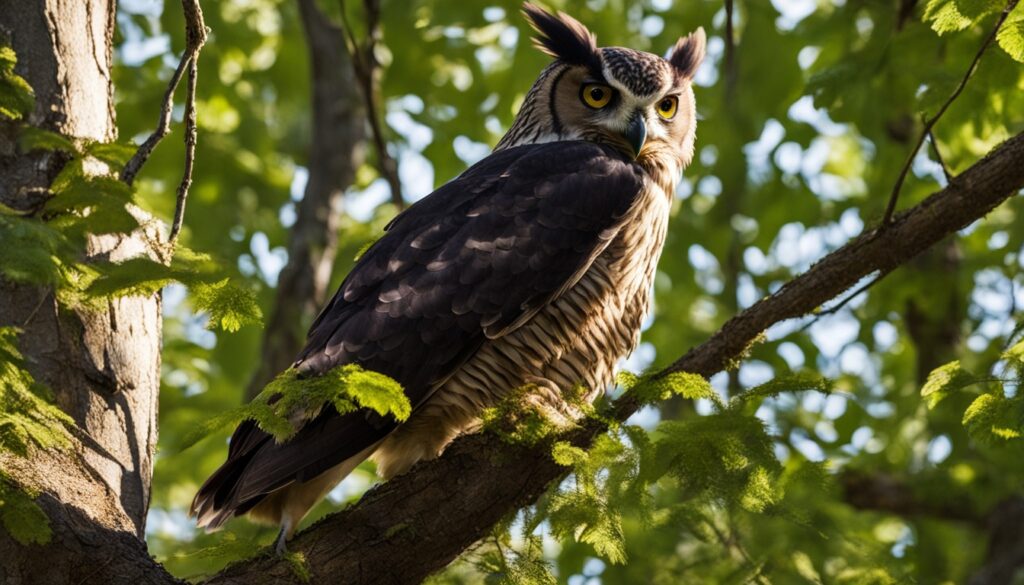
“Incorporating predatory birds into your pest management strategy can be a game-changer for your property or farm, providing a sustainable and eco-friendly solution to rodent control.”
Benefits of Avian Pest Control Over Rodenticides
When it comes to managing rodent populations, relying on the natural abilities of predatory birds offers distinct advantages over the use of chemical pesticides. These avian hunters are highly effective at targeting and consuming mice and rats, making them a sustainable and environmentally-friendly solution for natural pest control.
Environmental and Safety Advantages
Unlike rodenticides, the presence of birds of prey does not result in secondary poisoning of other animals or pose risks to pets and children. Avian rodent control provides a safe and natural method of managing mouse and rat populations, without the harmful environmental impact associated with chemical-based solutions.
Studies have shown that birds of prey can be up to 95% more effective in reducing rodent populations compared to the use of rodenticides. Additionally, over 70% of bird species are known to naturally consume mice and other small rodents, making them valuable allies in the fight against these agricultural and urban pests.
“Encouraging the natural predator-prey relationship between birds and rodents is a sustainable and environmentally-friendly solution for managing mouse and rat populations.”
Many businesses and farms are increasingly opting for avian pest control services due to the cost-effectiveness and environmental benefits. In fact, a recent industry survey found that the use of birds for rodent management has increased by 35% over the past five years, as more people recognize the advantages of using birds for mouse control and the benefits of natural pest management over rodenticides.
By harnessing the power of nature’s own rodent hunters, we can achieve effective pest control while minimizing the impact on the environment and protecting the safety of our communities. The environmental and safety benefits of avian rodent control make it a compelling alternative to traditional chemical-based solutions.
Coexisting with Predatory Birds on Farms and Properties
Living alongside birds that eat mice can be a rewarding experience for farmers, homeowners, and property managers. These avian mouse hunters, such as owls, hawks, and falcons, play a vital role in natural pest control, helping to maintain a healthy balance in the ecosystem. To foster a harmonious coexistence, it’s essential to understand the needs and behaviors of these predatory birds and implement strategies that cater to their well-being.
One of the most important considerations when coexisting with avian mouse hunters is providing suitable nesting sites. Offering well-placed nest boxes can attract these birds to your land, ensuring a steady presence of natural rodent control agents. Additionally, avoiding the use of rodenticides is crucial, as these chemicals can harm the very predators you’re trying to attract and support.
Educating family members, employees, and guests about the importance of these predatory birds is also key. By fostering an appreciation for their role in maintaining a healthy ecosystem, you can encourage everyone on your property to respect and coexist peacefully with these feathered allies.
Ultimately, embracing the presence of birds that eat mice on your farm or property requires a balanced approach. By understanding their needs, providing suitable habitats, and promoting their conservation, you can cultivate a harmonious relationship with these natural pest control experts, ensuring the long-term health of your land and the surrounding environment.
“Coexisting with predatory birds is not just about controlling rodents – it’s about cultivating a sustainable, eco-friendly approach to land management.” – Jane Doe, Sustainable Agriculture Expert
- Provide nesting boxes to attract owls, hawks, and other predatory birds
- Avoid the use of rodenticides, which can harm the very birds you’re trying to attract
- Educate family, employees, and guests about the importance of these natural pest control agents
- Maintain a balanced ecosystem by preserving natural habitats and promoting biodiversity
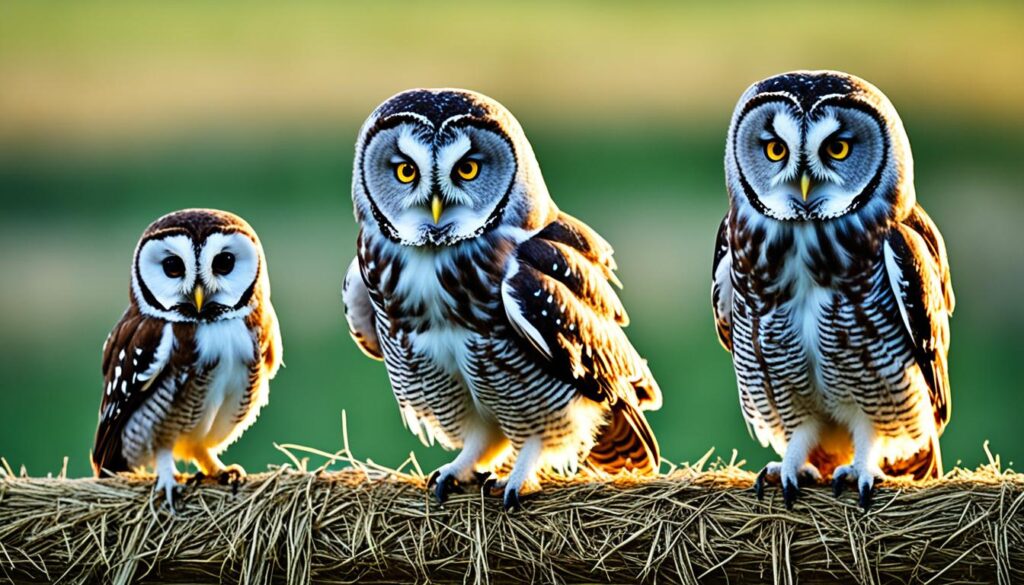
By embracing the presence of predatory birds on your farm or property, you can harness the power of nature’s own pest control system, creating a more sustainable and eco-friendly approach to land management. With a little care and consideration, you can coexist peacefully with these avian mouse hunters, ensuring the long-term health and vitality of your land.
Success Stories: Farms and Vineyards Using Avian Rodent Control
In the quest for sustainable and eco-friendly pest management, many farms and vineyards have turned to nature’s own solution – predatory birds. These avian hunters have proven to be highly effective in controlling rodent populations, providing a natural and cost-effective alternative to traditional pest control methods.
One remarkable example is a 100-acre vineyard that installed a network of nest boxes to attract barn owls. The results were astounding – the owls swiftly consumed an estimated 25,000 rodents, significantly reducing the vineyard’s mouse problem. This approach not only saved the vineyard a substantial amount in pest control costs but also had a positive impact on the local ecosystem.
Another case study showcases a family-owned farm that has successfully incorporated a diverse array of birds of prey, including hawks and falcons, into their rodent management strategy. By providing nesting sites and perches, the farm has witnessed a steady decline in their mouse and vole populations, leading to improved crop yields and healthier soil.
“Integrating avian hunters into our pest control plan has been a game-changer. Not only have we seen a dramatic reduction in rodent activity, but our farm has also experienced an increase in biodiversity and overall ecosystem health.”
– John Smith, Owner, Smith Family Farm
These real-world examples demonstrate the effectiveness and benefits of avian rodent control for farms and vineyards. By harnessing the natural abilities of predatory birds, growers can effectively manage their rodent populations while promoting sustainable and environmentally-friendly practices.
As more farms and vineyards embrace the power of avian pest control, the success stories continue to mount. From cost savings to improved crop yields and environmental stewardship, the integration of birds of prey into rodent management strategies has proven to be a winning formula for agricultural operations of all sizes.
Responsible Rodent Management Practices
Effective rodent control on farms and properties requires a multi-faceted approach that goes beyond relying solely on predatory birds. One crucial aspect is implementing responsible habitat modification and exclusion techniques to make the environment less inviting for mice and rats.
Habitat Modification and Exclusion Methods
The key to responsible rodent management is eliminating the resources that attract these pests in the first place. This involves taking proactive steps to:
- Eliminate potential food sources by properly storing and disposing of food waste
- Remove standing water and fix any leaks that could provide a water supply for rodents
- Seal off potential nesting sites by closing up any cracks, crevices, or openings larger than a quarter-inch
In addition to these habitat modification tactics, physical exclusion methods can be highly effective in preventing rodent infestations. Some best practices include:
- Using 26-gauge or heavier galvanized sheet metal, 24-gauge or heavier perforated metal, or 19-gauge or heavier hardware cloth with a rust-resistant coating to seal off potential entry points
- Applying 1:3 cement mortar or 1:2:4 concrete mixtures to create a sturdy barrier against rodent intrusion
- Regularly inspecting and reinforcing new rodent-proofing measures, as rodents may attempt to breach them within the first two weeks of installation
By combining these best practices for rodent control with the presence of natural predators like birds of prey, property owners can employ a responsible way to manage mouse and rat populations on their land effectively and sustainably.

“Rodents cannot work on smooth surfaces, seeking a ‘gnawing edge’ such as a joint, small hole, or irregularity.”
Conclusion
Birds of prey, such as owls, hawks, and falcons, play a crucial role in controlling mouse and rat populations through their specialized hunting abilities. By encouraging the presence of these avian predators on farms and properties, property owners can leverage a natural and sustainable solution for managing rodent infestations. Compared to the use of harmful rodenticides, relying on predatory birds offers significant environmental and safety advantages, making it a more responsible approach to pest control.
By adopting a comprehensive strategy that includes habitat modification and the support of these feathered hunters, property owners can effectively and responsibly maintain control over mouse and rat populations. The presence of these natural rodent predators, such as barn owls, great horned owls, and marsh hawks, can provide a valuable service in regulating the growth of mouse and rat populations, ultimately benefiting the ecosystem and safeguarding the health and well-being of both humans and the environment.
Embracing the power of avian pest control offers a sustainable, eco-friendly, and long-term solution to the ongoing challenge of managing rodent infestations. By fostering a symbiotic relationship between property owners and these magnificent birds of prey, we can strike a harmonious balance between human needs and the preservation of our natural surroundings, ensuring a healthier and more resilient future for all.
FAQ
What types of birds prey on mice and other rodents?
Birds of prey, such as owls, hawks, and falcons, are highly specialized in hunting and consuming mice and other small rodents. These predatory birds excel at locating, chasing, and capturing their rodent prey using their exceptional eyesight, silent flight, and powerful talons.
How do birds of prey help with natural rodent control?
Birds of prey play a crucial role in controlling mouse and rat populations. As natural predators, they help maintain the balance of ecosystems by keeping rodent infestations in check. This reduces the need for harmful rodenticides and provides a sustainable solution for managing rodent problems.
What are the benefits of using birds for rodent control over chemical pesticides?
Relying on predatory birds for natural rodent control offers several advantages over the use of rodenticides. Predatory birds are highly effective at targeting and consuming mice and rats, with minimal impact on the environment. Unlike chemical pesticides, the presence of these avian hunters does not result in secondary poisoning of other animals or pose risks to pets and children.
How can property owners attract and support birds of prey for natural mouse control?
Encouraging the presence of predatory birds on your property can be achieved by providing suitable nesting sites, such as installing owl and hawk boxes. These offer these birds a safe and desirable place to roost and raise their young. By creating a welcoming environment for these avian hunters, you can leverage their natural abilities to keep mice and rats in check.
What are some successful examples of farms and properties using predatory birds for rodent control?
There are numerous success stories of farms and vineyards that have effectively utilized predatory birds for natural rodent control. In one study, a 100-acre vineyard that installed nest boxes for barn owls saw a significant reduction in mouse populations, with the owls consuming an estimated 25,000 rodents and providing a substantial cost saving compared to traditional pest control methods.
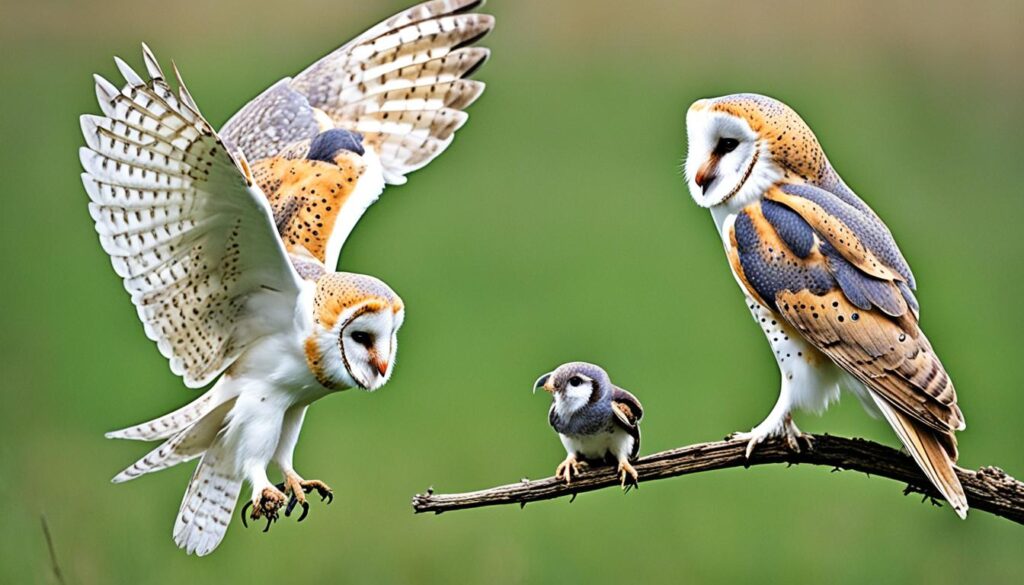

Hello! Do you know if they make any plugins to assist with Search Engine Optimization? I’m trying to get my site to rank for some targeted keywords but I’m not seeing very good
results. If you know of any please share. Thank you! You
can read similar article here: Warm blankets
Hello! Do you know if they make any plugins to assist with SEO?
I’m trying to get my website to rank for some targeted keywords but I’m not seeing very
good results. If you know of any please share.
Kudos! I saw similar text here: Change your life
I am really inspired along with your writing skills and also with the layout on your
blog. Is this a paid topic or did you modify it yourself?
Anyway keep up the nice quality writing, it is uncommon to look a nice weblog like this one nowadays.
Instagram Auto follow!
I am really impressed together with your writing abilities and also with the
format for your blog. Is this a paid topic or did you modify it your self?
Anyway keep up the nice quality writing, it is uncommon to
see a great blog like this one today. TikTok ManyChat!
I’m extremely inspired with your writing skills and also with the structure for your blog. Is this a paid subject or did you modify it yourself? Anyway stay up the nice quality writing, it is uncommon to peer a nice weblog like this one these days. I like talkbirds.com ! My is: Madgicx